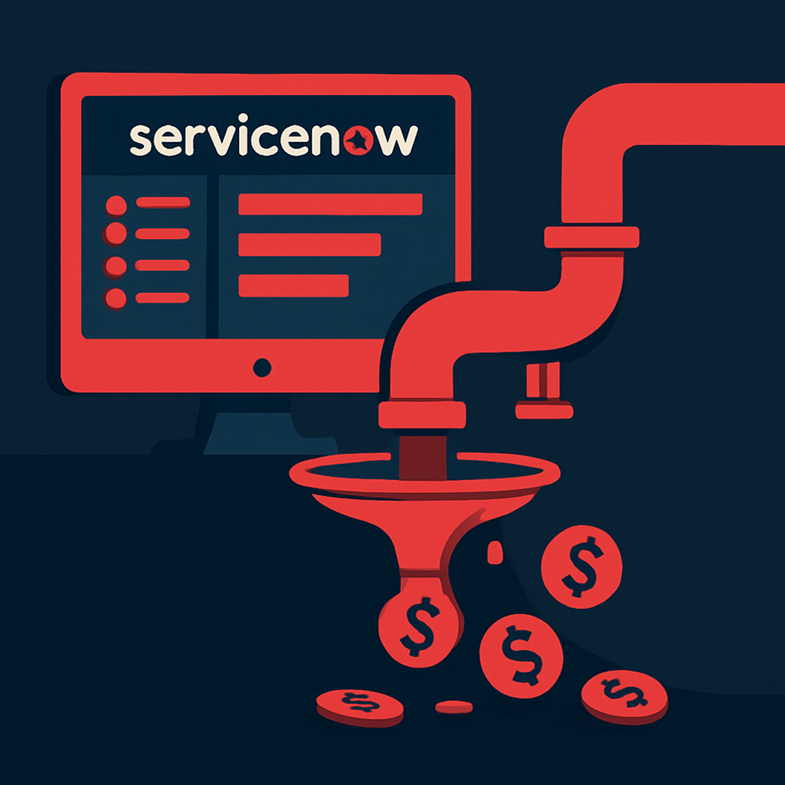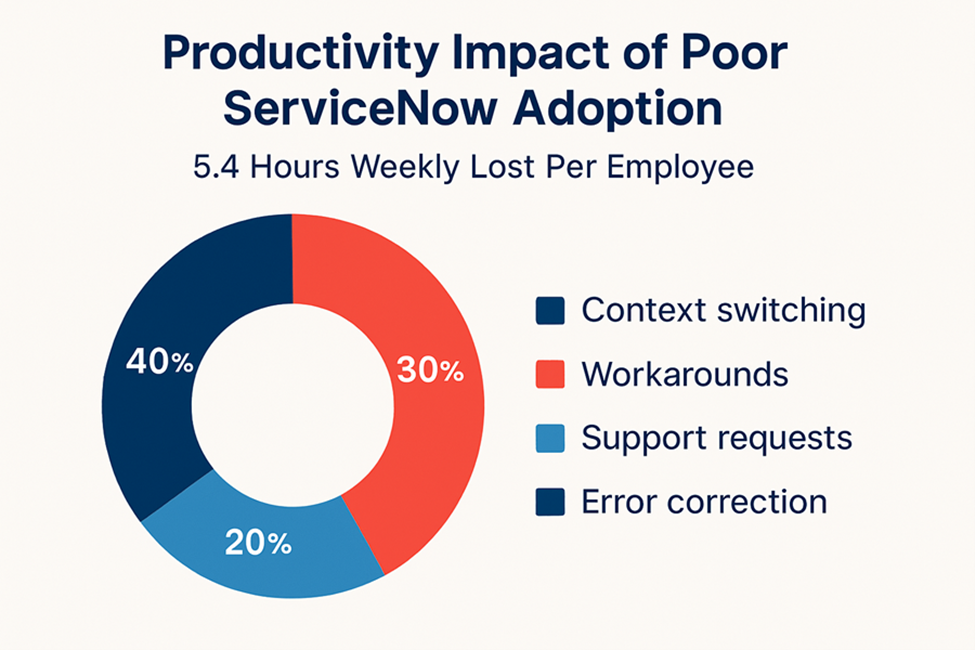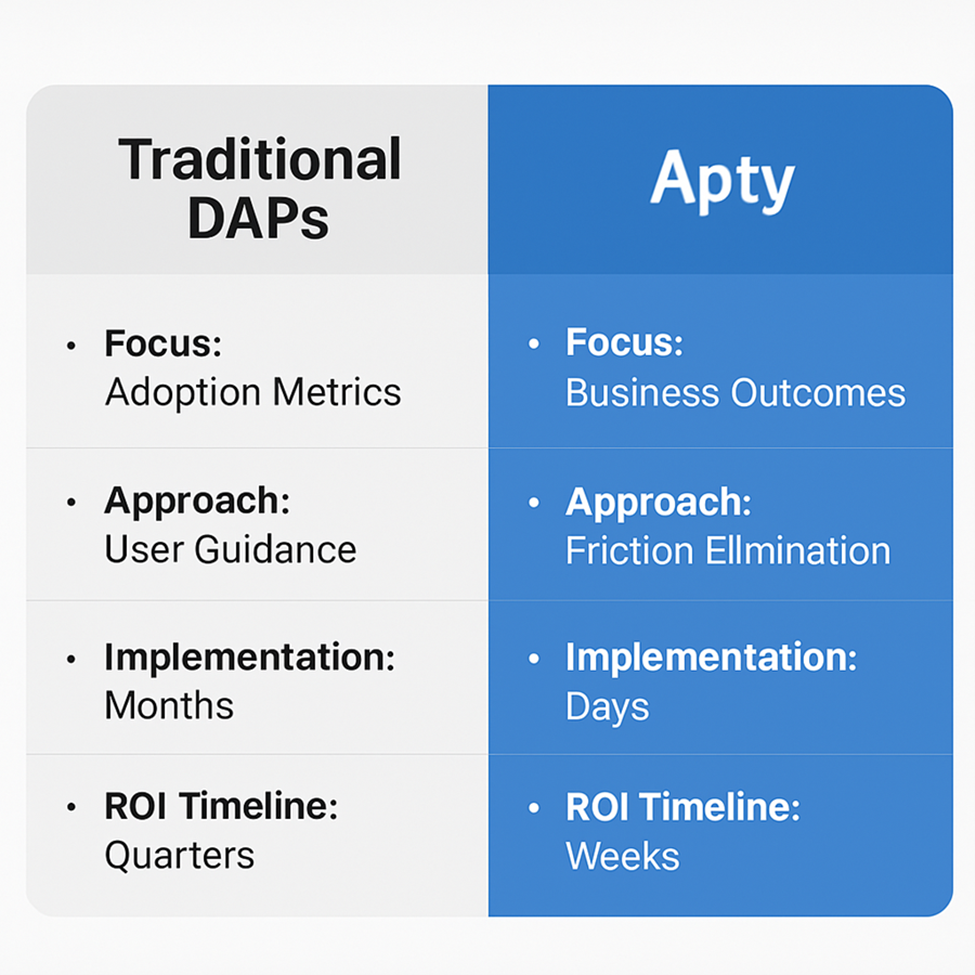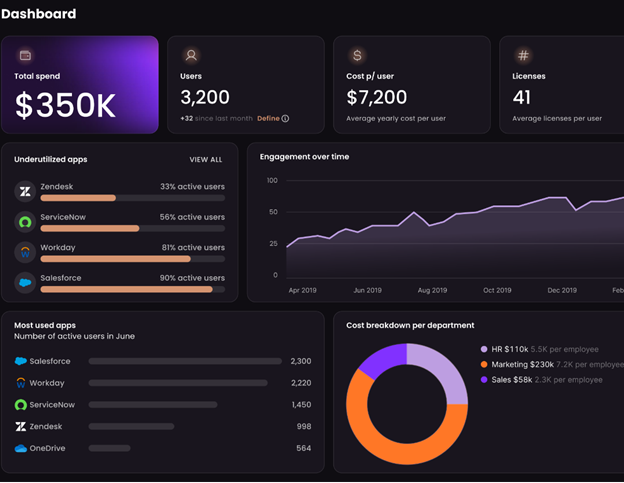Table of Contents
- Introduction: The ServiceNow Investment Reality Gap
- The Visible vs. Hidden Costs of ServiceNow
- The Employee Experience Impact: Beyond Dollars and Cents
- The Data Quality Crisis: Garbage In, Strategic Failure Out
- Beyond Traditional DAPs: Why Conventional Approaches Fail
- Apty’s Capabilities: Transforming ServiceNow Adoption
- Real-Time Adoption Analytics and Insights
- How Apty’s Digital Adoption Works
- Contextual In-App Guidance When Users Need It Most
- Process Completion Tracking and Optimization
- AI-Powered Adoption Insights and Recommendations
- Cross-Application Process Support
- The Bottom Line: Business Outcomes, Not Just User Guidance
- The Apty Difference: Beyond Adoption to Business Acceleration
- Case Study: Global Financial Services Firm Transforms ServiceNow Adoption
- Conclusion: The Path Forward

Introduction: The ServiceNow Investment Reality Gap
Organizations worldwide are pouring millions into ServiceNow implementations, expecting transformative results across IT service management, customer service, and business workflows. Yet a disturbing reality lurks beneath these ambitious digital transformation initiatives: 90% of organizations fail to realize ServiceNow’s full potential due to poor adoption and implementation challenges.
This isn’t just another technology adoption problem—it’s a silent financial hemorrhage that’s draining IT budgets, frustrating employees, and undermining the very digital transformation initiatives meant to propel businesses forward.
The numbers tell a sobering story. According to recent findings, enterprises lost an estimated $43 million in 2024 alone due to poor visibility and underutilization of enterprise software. For ServiceNow specifically, organizations typically capture only 30% of the platform’s potential value, leaving a staggering 70% of ROI unrealized.
In this article, we’ll uncover the true costs of poor ServiceNow adoption—costs that extend far beyond the obvious licensing fees and implementation expenses. More importantly, we’ll explore how forward-thinking organizations are moving beyond traditional Digital Adoption Platforms (DAPs) to ensure their ServiceNow investments deliver the promised returns.
Read more about: ServiceNow Implementation Cost: Everything You Need to Know

The Visible vs. Hidden Costs of ServiceNow
When organizations budget for ServiceNow, they typically account for the visible costs:
- Licensing fees (often $100+ per user monthly for enterprise implementations)
- Implementation services (averaging $250,000–$500,000 for mid-sized deployments)
- Basic training and change management
- Ongoing maintenance and support
What they fail to calculate are the hidden costs that emerge when adoption falters:

1. Wasted Software Spend
The most immediate hidden cost is the direct financial waste from underutilized licenses. According to ServiceNow implementation metrics from CRI Advantage, organizations with poor adoption strategies see utilization rates below 40%, meaning more than half of their ServiceNow investment delivers zero return.
For a 1,000-user implementation at enterprise-level pricing, this translates to approximately $720,000 annually in wasted license spend alone.
But license waste is just the beginning.
2. Shadow IT Proliferation
When ServiceNow fails to meet user needs due to adoption barriers, employees inevitably create workarounds. A 2025 study by Trufflow found that 83% of employees use unauthorized software solutions when official tools prove difficult to use.
These shadow IT solutions create:
- Security vulnerabilities: Unauthorized tools operate outside security protocols
- Data silos: Critical information becomes trapped in disconnected systems
- Compliance risks: Regulatory requirements are compromised
- Additional hidden costs: Duplicate software purchases across departments
The financial impact? Organizations spend an additional $4,000–$8,000 per employee annually on redundant tools and remediation efforts when primary systems like ServiceNow go underutilized.
3. IT Support Burden
Poor ServiceNow adoption creates a paradoxical outcome: a platform designed to streamline IT support actually increases the support burden. According to ServiceNow’s own community data, organizations with low adoption rates experience:
- 65% higher ticket volumes related to platform usage questions
- 40% longer resolution times due to inconsistent process adherence
- 3x higher escalation rates to specialized support teams
This support burden diverts IT resources from strategic initiatives to mundane troubleshooting, creating a negative feedback loop that further undermines digital transformation efforts.
4. Process Inefficiency and Error Rates
ServiceNow implementations aim to standardize and optimize business processes. When adoption falters, these processes remain inconsistent, manual, and error-prone.
Recent analysis from Beyond20 reveals that organizations with poor ServiceNow adoption experience:
- 30–45% higher error rates in critical business processes
- 25% longer process completion times
- 60% more process exceptions requiring manual intervention
Each error and exception carries its own cost in rework, delays, and customer dissatisfaction—costs that compound over time and across departments.
The Employee Experience Impact: Beyond Dollars and Cents
While financial metrics capture attention, the human cost of poor ServiceNow adoption may be even more significant in the long run.

Employee Frustration and Resistance
According to ServiceNow’s community forums, low adoption rates correlate strongly with negative user perceptions. In a March 2025 analysis, organizations with adoption challenges reported:
- Negative perceptions of the ServiceNow implementation
- High user frustration levels
- Resistance to future technology initiatives
This frustration creates a vicious cycle: employees avoid using ServiceNow, which prevents them from developing proficiency, which further increases frustration and avoidance.
Productivity Drain
The productivity impact extends far beyond the obvious time spent struggling with unfamiliar interfaces. Research from HTEC in 2025 identified several hidden productivity costs:
- Context switching penalties: Employees jumping between ServiceNow and workaround systems lose 40% efficiency during transitions
- Knowledge sharing barriers: When adoption is inconsistent, team collaboration suffers
- Decision-making delays: Incomplete data in ServiceNow leads to postponed or flawed decisions
For knowledge workers, these hidden productivity drains can consume up to 5.4 hours weekly—more than half a workday lost to poor system adoption.

Training Investment Waste
Organizations typically invest in initial ServiceNow training, but without ongoing adoption support, this investment yields diminishing returns. Studies show that employees forget 70% of training content within one week without reinforcement.
This forgetting curve means that traditional “one-and-done” training approaches for ServiceNow are essentially throwing money away, with minimal lasting impact on adoption or proficiency.
The Data Quality Crisis: Garbage In, Strategic Failure Out
Perhaps the most insidious cost of poor ServiceNow adoption is its impact on data quality and the resulting strategic implications.
The Data Integrity Problem
When users avoid ServiceNow or use it inconsistently, the platform’s database becomes:
- Incomplete (missing critical information)
- Inaccurate (containing errors and outdated data)
- Inconsistent (varying in quality across departments)
According to a 2025 analysis by CEO Review, organizations with poor enterprise software adoption experience data quality degradation of 40–60% compared to those with strong adoption programs.
The Strategic Decision Impact
This data quality crisis undermines the very strategic insights ServiceNow is meant to provide:
- Flawed reporting: Executives make decisions based on incomplete information
- Inaccurate forecasting: Resource planning becomes guesswork rather than data-driven
- Missed optimization opportunities: Process improvement initiatives lack reliable baseline data
The strategic cost? Organizations make multi-million dollar decisions based on fundamentally flawed information, perpetuating inefficiencies rather than addressing them.
Beyond Traditional DAPs: Why Conventional Approaches Fail
Many organizations attempt to address ServiceNow adoption challenges with traditional Digital Adoption Platforms (DAPs). While these tools offer basic guidance and training, they fall short in addressing the fundamental issues:
The Limitations of Traditional DAPs
- Focus on surface-level adoption, not business outcomes: Traditional DAPs measure clicks and completions, not actual business impact
- Static, one-size-fits-all guidance: They fail to adapt to different user needs and learning styles
- Limited cross-application support: They struggle with complex workflows that span multiple systems
- Reactive rather than proactive assistance: They wait for users to encounter problems rather than preventing them
- Implementation complexity: They often require months of setup and specialized skills
These limitations explain why many organizations see minimal improvement in ServiceNow ROI even after implementing traditional DAPs.
Apty’s Capabilities: Transforming ServiceNow Adoption
While traditional Digital Adoption Platforms (DAPs) focus primarily on surface-level guidance, Apty takes a fundamentally different approach to ServiceNow adoption. Apty doesn’t just guide users—it transforms the entire ServiceNow experience by addressing the root causes of poor adoption and delivering measurable business outcomes.

AI-Driven Adoption Intelligence
Apty’s AI-driven capabilities identify adoption challenges at the user level and provide targeted guidance at the exact moment of need. With continuous monitoring and intelligent assistance, Apty enhances every aspect of the ServiceNow experience, making the platform more intuitive and accessible for all users.
Apty’s AI-driven capabilities identify adoption challenges and provide targeted guidance exactly when users need it, resulting in 3X faster process completion and improved content utilization.
Real-Time Adoption Analytics and Insights
One of the most powerful capabilities Apty brings to ServiceNow is its comprehensive analytics dashboard. Unlike basic usage metrics, Apty provides deep insights into how employees are actually using ServiceNow, where they’re struggling, and what processes are causing bottlenecks.

The Apty ServiceNow Adoption Dashboard gives leadership teams unprecedented visibility into:
- User adoption rates across different departments and roles
- Task completion rates for critical ServiceNow workflows
- Time to proficiency for new users
- Process bottlenecks and abandonment points
- ROI metrics that quantify the business impact of improved adoption
This level of insight allows organizations to make data-driven decisions about where to focus their adoption efforts, rather than relying on guesswork or anecdotal feedback.
How Apty’s Digital Adoption Works
Apty’s approach to digital adoption is systematic and outcome-focused. The platform guides users through their ServiceNow journey, ensuring they can complete processes successfully while simultaneously gathering data on usage patterns and pain points.
Apty’s digital adoption methodology unlocks software value through guided user journeys that ensure successful process completion and continuous improvement.
Contextual In-App Guidance When Users Need It Most
Apty’s guided walkthroughs fundamentally change how users experience ServiceNow. Rather than overwhelming employees with one-time training sessions they’ll quickly forget, Apty provides step-by-step guidance at the exact moment users need help.

These intelligent walkthroughs:
- Detect when users are struggling and proactively offer assistance
- Break complex ServiceNow processes into simple, manageable steps
- Adapt to different user roles and experience levels
- Reduce support tickets and IT team burden
- Accelerate time-to-proficiency for new ServiceNow users
The result is a dramatic reduction in user frustration and a significant increase in successful task completions—directly addressing the hidden costs of poor adoption we’ve discussed throughout this article.
Process Completion Tracking and Optimization
Beyond simple guidance, Apty tracks process completion rates and identifies exactly where users are abandoning critical ServiceNow workflows.

This capability allows organizations to:
- Identify specific steps where users consistently struggle
- Redesign problematic processes for better usability
- Deploy targeted guidance at known friction points
- Measure improvements in completion rates over time
- Quantify the business impact of process optimizations
This data-driven approach to process optimization ensures that ServiceNow delivers its promised value, rather than becoming another underutilized enterprise software investment.
AI-Powered Adoption Insights and Recommendations
Apty’s advanced analytics go beyond simple reporting to provide actionable intelligence. The platform analyzes user behavior patterns to deliver prescriptive recommendations for improving ServiceNow adoption.

These AI-powered insights help organizations:
- Predict which user groups are at risk of poor adoption
- Identify training gaps before they impact productivity
- Receive automated recommendations for process improvements
- Quantify the financial impact of adoption challenges
- Measure the ROI of adoption initiatives
By transforming raw data into actionable intelligence, Apty empowers organizations to continuously optimize their ServiceNow implementation for maximum business impact.
Read more about: The Business Outcomes with Apty
Cross-Application Process Support
Unlike basic DAPs that only work within a single application, Apty supports end-to-end processes that span multiple systems—a critical capability for ServiceNow environments that integrate with other enterprise applications.

This cross-application support ensures that:
- Users can complete complex workflows that extend beyond ServiceNow
- Adoption metrics capture the full process, not just isolated tasks
- Organizations can identify bottlenecks across the entire workflow
- Training and guidance remain consistent across all applications
- The full business value of ServiceNow integrations is realized
For organizations that have invested in ServiceNow as part of a broader digital transformation, this cross-application capability is essential for driving holistic adoption.
The Bottom Line: Business Outcomes, Not Just User Guidance
What truly sets Apty apart is its focus on business outcomes rather than superficial adoption metrics. While traditional DAPs might celebrate increased click-through rates or reduced support tickets, Apty measures success by the metrics that actually matter to your business:
- Reduced operational costs
- Increased process completion rates
- Faster time-to-value for ServiceNow investments
- Improved employee productivity and satisfaction
- Quantifiable ROI on your ServiceNow implementation
By addressing the root causes of poor adoption and focusing on measurable business outcomes, Apty transforms ServiceNow from an underutilized expense into a powerful driver of organizational efficiency and value.
In an era where the hidden costs of poor software adoption can easily outweigh the visible licensing costs, Apty’s comprehensive approach to ServiceNow adoption isn’t just nice to have—it’s a business imperative for organizations serious about maximizing their technology investments.
The Apty Difference: Beyond Adoption to Business Acceleration
The solution to poor ServiceNow adoption isn’t just another layer of technology—it’s a fundamentally different approach to digital adoption that focuses on business outcomes rather than surface-level metrics.
Business Impact, Not Just Adoption
Unlike traditional DAPs that stop at adoption, Apty focuses on what actually matters: business results. This means:
- Measuring error reduction: Apty reduces process errors by 30%, directly improving data quality and operational efficiency
- Tracking process completion improvements: Organizations using Apty see 45% higher process completion rates
- Quantifying cross-application efficiency: Apty delivers a 27% efficiency boost across integrated applications
- Calculating real ROI: Apty customers achieve 3.4x ROI in the first year
Eliminating Friction, Not Just Providing Guidance
Traditional DAPs show users where to click. Apty eliminates the need for guidance by making complex processes intuitive:
- Automated form filling: Reducing data entry time by up to 60%
- Contextual validation: Preventing errors before they occur
- Process simplification: Turning multi-step workflows into streamlined experiences
- Cross-application support: Guiding users seamlessly across integrated systems
Rapid Time-to-Value, Not Implementation Marathons
While traditional DAPs require months of setup, Apty delivers measurable results in days:
- 80% faster setup compared to traditional DAPs
- Implementation timeline of weeks, not months
- First measurable results within 14 days
- No specialized technical skills required
This rapid time-to-value means organizations can validate Apty’s impact before committing to enterprise-wide deployment, reducing risk and accelerating ROI.
Case Study: Global Financial Services Firm Transforms ServiceNow Adoption
A global financial services organization with over 15,000 ServiceNow users was struggling with adoption challenges that mirrored many of the hidden costs we’ve discussed:
- Low utilization rates across key ServiceNow modules
- High support ticket volumes for basic ServiceNow functions
- Process abandonment at critical workflow steps
- Data quality issues affecting strategic decision-making
After implementing Apty, the organization experienced:
- 42% reduction in ServiceNow-related support tickets
- 68% improvement in process completion rates
- 3.2x increase in self-service resolution
- $1.2 million annual savings in support costs alone
- 29% faster time-to-proficiency for new ServiceNow users
The most significant impact? The organization finally achieved the strategic benefits they had originally expected from their ServiceNow implementation, transforming it from a cost center to a value driver.
Conclusion: The Path Forward
The hidden costs of poor ServiceNow adoption represent a significant drain on organizational resources, employee productivity, and strategic potential. Traditional approaches to adoption—including conventional DAPs—fail to address the root causes of these challenges.
Apty’s business-first approach to digital adoption transforms how organizations implement and utilize ServiceNow, ensuring that investments deliver their promised returns. By focusing on measurable business outcomes rather than superficial adoption metrics, Apty helps organizations:
- Eliminate wasted software spend by maximizing utilization
- Reduce shadow IT proliferation by making ServiceNow intuitive and effective
- Decrease IT support burden through proactive guidance and self-service enablement
- Improve process efficiency and reduce errors with contextual assistance
- Enhance employee experience and eliminate adoption resistance
- Boost productivity by streamlining workflows and eliminating friction
- Ensure data quality for strategic decision-making
- Accelerate time-to-value for ServiceNow investments
Organizations can no longer afford to ignore the hidden costs of poor ServiceNow adoption. The question isn’t whether you can afford to invest in a solution like Apty—it’s whether you can afford not to.
Ready to transform your ServiceNow adoption and unlock the platform’s full potential?
Book a Demo today to see how Apty can help your organization eliminate the hidden costs of poor adoption and maximize your ServiceNow ROI.

